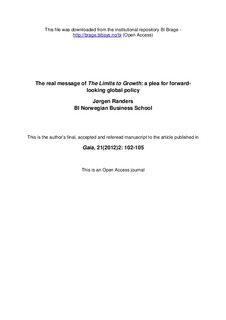The real message of The Limits to Growth: a plea for forward-looking global policy
Journal article, Peer reviewed
Permanent lenke
http://hdl.handle.net/11250/93630Utgivelsesdato
2012Metadata
Vis full innførselSamlinger
- Scientific articles [2181]
Sammendrag
The book The Limits to Growth (Meadows et al. 1972) has been discussed aggressively for decades. Still it is not commonly known what this research report really did say when it was first published in March 1972. Many believe that The Limits to Growth (LtG) forecast the end of the world before the year 2000, using a big mathematical model of the world system. Others believe that LtG was a neo-Malthusian projection of population collapse in the 21st century, caused by global shortages of natural resources including oil and agricultural land. Others again think that it proved that economic growth cannot continue forever on a finite planet (see, e. g., Bardi 2008).
Very few seem to know that LtG was a scenario analysis of twelve possible futures from 1972 to 2100. And that the main scientific conclusion of the study was that delays in global decision making would cause the human economy to overshoot planetary limits before the growth in the human ecological footprint slowed.Once in unsustainable territory, human society would be forced to reduce its rate of resource use and its rate of emissions. This contraction could only happen in two ways: either through “managed decline” organized by humanity, or through “collapse” induced by nature or the market. The only thing that could not happen was for world society to remain forever in unsustainable territory, using more of nature every year than nature produces during that year. Irrespective of what it really said, “growth will come to an end” was the imprecise summary that stuck with the book. This was unfortunate, because most believed that LtG spoke about “economic” growth, while it really spoke about growth in “the human ecological footprint” – an important distinction, because LtG opened for endless economic growth (in economic value) as long as that growth is not associated with growing physical impacts (e.g., in resource use or pollution output).
Beskrivelse
This was an Open Access journal
